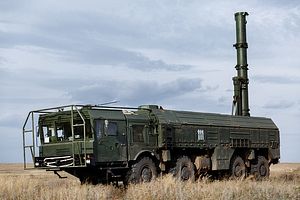Beginning in 2014, the U.S. State Department has noted repeatedly in its annual arms control compliance report that it had assessed that Russia was in violation of its commitments under the 1987 Intermediate-Range Nuclear Forces Treaty. Earlier this year, the Trump administration made clear that it would soon be withdrawing from the treaty. (Background on what the INF Treaty does is available here.)
While the United States has yet to give its formal withdrawal notice, there appears to be no real prospect of saving the INF Treaty. The alleged Russian violation has been cited by the administration as one of the reasons for U.S. withdrawal, but the truth is likely simpler: John Bolton, the current U.S. national security adviser, hasn’t seen an arms control agreement that he likes and has been a driver behind the withdrawal process.
For the last four years, while the fact of the United States’ claim of a Russian violation has been public, the precise nature of Russia’s violation wasn’t known. All Washington made clear was that Russia had developed, tested, and deployed a new ground-launched cruise missile with a range capability in the range banned by the treaty (500 to 5,500 km). Even the missile’s Russian designator, Novator 9M729, was confirmed only in a December 2017 speech by a senior Trump administration official. (The missile is known by NATO as the SSC-8 SCREWDRIVER.)
That all changed last week. On Friday evening, the U.S. Director of National Intelligence Dan Coats released the most detailed U.S. description of the specific nature of Russia’s violation. The release came after a detailed press conference by Sergey Ryabkov, Russia’s deputy foreign minister, on Monday, discussion Moscow’s position on the alleged violation and its own allegations toward U.S. violations of the INF Treaty. (I won’t get into those here, but Russia basically sees armed drones, ballistic missile target missiles used in missile defense tests, and the land-based Mk41 vertical launch system as U.S. violations of the treaty.)
Coats’ released account of the violation is worth reading in full for anyone that has been following the INF issue. It helps answer partly why the Obama administration may not have released “smoking gun” evidence of the Russian violation earlier. In Coats’ account, the Russian violation was a little bit less straightforward than had been assumed in some accounts; Russia hadn’t just developed and tested a missile to INF-proscribed ranges from a mobile ground-launcher, but it had gone about the development program in a more furtive manner.
Coats notes that the treaty allowed Russia to test missiles from a fixed launcher “as long as you do not intend to base them on the ground.” This means that systems like submarine- and ship-launched cruise missiles that fly to INF-proscribed ranges can be tested on land in a fixed launcher configuration. Russia initially did exactly this with the missile that would become the 9M729. That same missile would then go on to be tested from a road-mobile launcher configuration to ranges under 500 km. That, however, does not leave the final system INF compliant. Because the 9M729 had been tested to longer ranges, it would immediately violate the treaty the moment it was placed on a road-mobile, ground-launcher, clarifying that the intent here was to develop and deploy a noncompliant road-mobile, ground-launched cruise missile. Here’s Coats’ full account:
While the INF Treaty bans all ground based missile systems within the prohibited range, it allows you to test missiles from a fixed launcher as long as you do not intend to base them on the ground. For example, basing missiles on ship or aircraft.
Aware of this treaty provision, Russia initially flight tested the 9M729 – a ground based missile – to distances well over 500 kilometers (km) from a fixed launcher. Russia then tested the same missile at ranges below 500km from a mobile launcher.
By putting the two types of tests together, Russia was able to develop a missile that flies to the intermediate ranges prohibited by the INF Treaty and launches from a ground-mobile platform.
Russia probably assumed parallel development – tested from the same site – and deployment of other cruise missiles that are not prohibited by the INF Treaty would provide sufficient cover for its INF violation.
The sources and methods associated with the United States’ assertions are probably the reason we didn’t see a publicized narrative around the violation during the Obama years. Technically, Russia never tested a road-mobile, ground-launched cruise missile to INF-proscribed ranges and likely imagined there would be sufficient plausible deniability by testing the missile from the static configuration.
Substantiating that the missiles tested from the fixed and mobile launcher configurations are both exactly the 9M729 would presumably require advanced methods, including telemetry intercepts. The United States has reportedly shared some of this intelligence now with its European allies to help make the case in favor of the Russian violation. Per Ryabkov’s statement on Monday, Russia has not seen definitive evidence of the violation. As far as Moscow is concerned, there is no violation still.
All of this helps resolve the curiosity behind the Russian violation itself, but present political realities suggest that Washington and Moscow won’t be convening the Treaty’s Special Verification Commission to resolve the matter of the violation anytime soon.

































